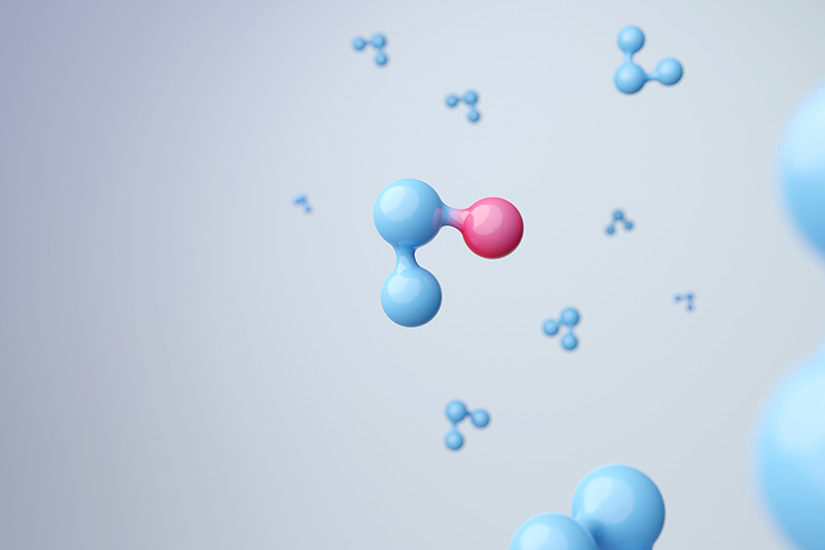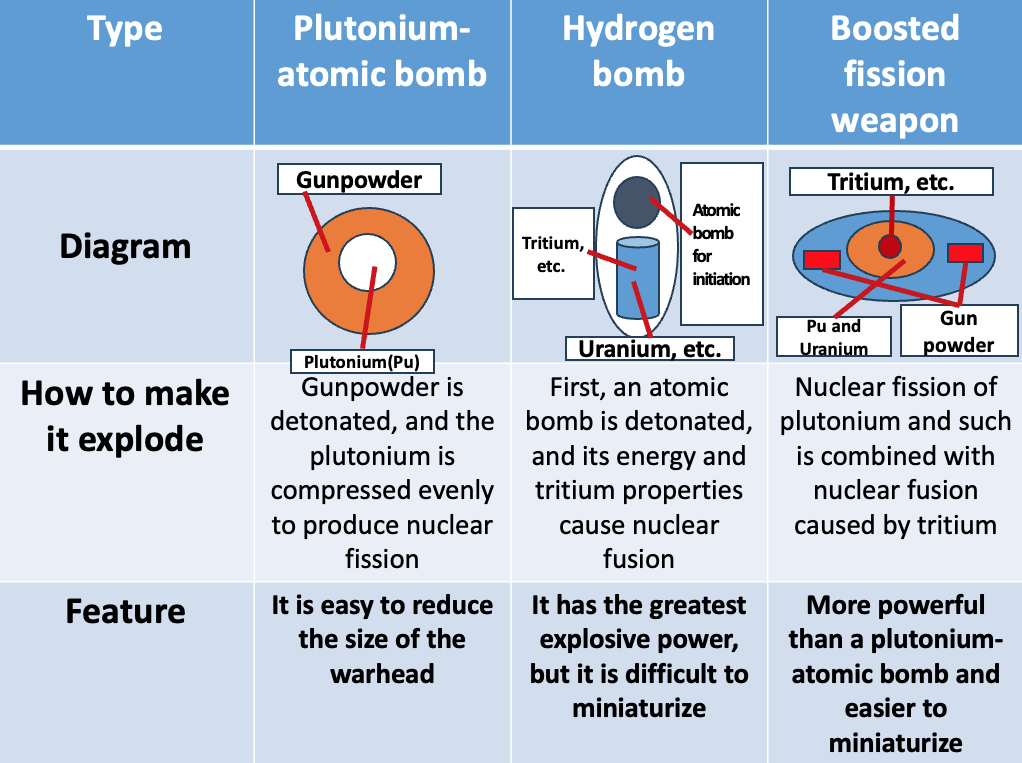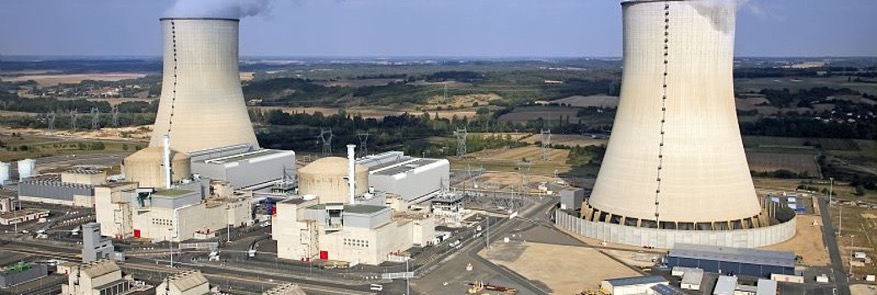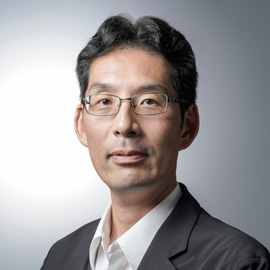Tritium and Nuclear Weapons
Tritium exists in nature and is produced as a byproduct of the combustion of uranium fuel in nuclear reactors. In Japan, tritium is known to be contained in ALPS treated water discharged into the ocean from the Tokyo Electric Power Company’s Fukushima Daiichi Nuclear Power Plant.[1] However, there is another aspect of this nuclear material: it plays an essential role in boosting the explosive power of nuclear weapons. In the context of the use of tritium in nuclear weapons, France has announced its intention to decommission its aging tritium-producing military reactors and, as an alternative, to produce tritium in commercial nuclear reactors by the end of 2025. It has become a point of contention among non-proliferation experts.[2]
Tritium is a short-lived nuclear material that needs to be regularly replenished to maintain the performance of nuclear weapons.[3] Reducing the costs of tritium production and maintaining the performance of nuclear weapons has become a public finance issue for nuclear powers. France’s abolition of military reactors for tritium production and its switch to the use of commercial reactors is seen as part of this effort.[4] Among the nuclear powers, the United States is already producing tritium using commercial nuclear reactors.
Neither the United States nor France intends to increase the production of nuclear materials that directly cause explosions, such as uranium and plutonium. Therefore, while not directly resulting in an enhancement of nuclear weapons, these acts by both countries could be perceived as the potential military diversion of civilian nuclear technology. They could also delay the efforts toward nuclear disarmament set forth in the Nuclear Non-Proliferation Treaty (NPT), which could lead to a backlash from non-nuclear powers.
In this paper, I outline the role of tritium in nuclear weapons and the policy of France, before examining the efforts of the United States as a precedent. Finally, I consider the problems inherent in tritium production using commercial nuclear reactors.

The Role of Tritium in Nuclear Weapons and France’s Plan
In Japanese, Tritium is referred to as "三重水素 (hydrogen-3)." As the name implies, it has similar properties to hydrogen and binds to water molecules. This is the reason why tritium is the only material that could not be removed using the dedicated ALPS system at the Fukushima Daiichi Nuclear Power Plant, which removes nuclear materials from contaminated water that was used to cool the nuclear fuel after the meltdown.[5] Tritium can be used to produce nuclear weapons with tremendous explosive power: tens or even thousands of times greater than that of the atomic bombs dropped on Hiroshima and Nagasaki. While conventional atomic bombs release energy through a fission chain reaction using uranium or plutonium as fuel, tritium enables nuclear fusion, in which multiple nuclei combine, producing a huge amount of energy in a single instant. The power of nuclear fusion is immensely greater than that of a fission reaction. A notable example of a nuclear weapon whose explosive power is enhanced by nuclear fusion is the hydrogen bomb (H-bomb). A bomb that incorporates a fusion reaction to increase its power is called a “boosted fission" weapon and is a precursor to a hydrogen bomb (see Figure 1).[6] Nuclear powers are using tritium for military purposes, developing small-scale hydrogen bombs and boosted fission weapons that can be mounted on intercontinental ballistic missiles (ICBMs). North Korea, in its sixth nuclear test in September 2017, announced that it had successfully tested a hydrogen bomb that can be mounted on an ICBM.[7]
Figure 1: Major Types of Nuclear Weapons

In this way, tritium has become an essential substance in the production of modern nuclear weapons, but it has the disadvantage of being short-lived. Tritium’s half-life — the time it takes for one-half of the nuclei of a radioactive isotope to decay — is 12.33 years, which is one of the shorter lifetimes among nuclear materials (see Table 1).
Table 1: Half-lives of Major Nuclear Materials
| Nuclear materials | Half-life |
|---|---|
| Uranium-238 | 4.5 billion years |
| Plutonium-239 | 24,000 years |
| Radium-226 | 1,600 years |
| Cesium-137 | 30 years |
| Tritium | 12.33 years |
| Xenon 138 | 14 points |
Therefore, in order to maintain the performance of nuclear weapons, it is necessary to replenish them with tritium every few years. This fact means that as long as countries possess nuclear weapons, they will need to continue producing tritium. To prepare nuclear warheads for potential deployment, they have no option but to implement systems to replenish them every few years.
In March 2024, France announced plans to decommission its tritium-only reactor and produce tritium at the Civaux Nuclear Power Plant (see Photo 1 and Table 2) in the country's midwestern province of Vienne.[8]This is believed to be an attempt to save on nuclear weapon maintenance costs. Last fall, Électricité de France (EDF), which owns the plant, submitted technical specifications to the French Authority for Nuclear Safety and Radiation Protection (ASNR), indicating its intention to begin test production of tritium in 2025,[9] but the ASNR has not yet approved the project.
Photo 1: Civaux Nuclear Power Plant

Table 2: Overview of the Civaux Nuclear Power Plant
| Name of the reactor | Type | Output (megawatts) | Operation start date |
|---|---|---|---|
| Civaux 1 | Pressurized water type | 1,495 | January 29, 2002 |
| Civaux 2 | Pressurized water type | 1,495 | April 23, 2002 |
Precedent: History and Current Status of Tritium Production in Commercial Nuclear Reactors in the United States
The United States closed tritium-producing military reactors in 1988 and moved on to consider the development of new military reactors. However, nuclear disarmament took a step forward with the end of the Cold War, as the Intermediate-Range Nuclear Forces Treaty (INF Treaty: 1988), aimed at the total abolition of intermediate-range nuclear weapons, and the Strategic Arms Reduction Treaty I (START I: 1994) between the United States and the Soviet Union (later, Russia) successively came into effect. Under START I, the total number of deployed strategic nuclear warheads was capped at 6,000. This almost halved the number of warheads that had been deployed since the Cold War, when the United States and the Soviet Union each deployed more than 10,000. This reduction raised concerns about the wisdom of building expensive new tritium-only reactors.[10] Nevertheless, 3 kilograms of tritium per year are required to maintain the performance of 6,000 warheads, and the United States Department of Energy (DOE) determined that tritium production would need to resume by 2005, based on the inventory levels at the time.[11]
Against this backdrop, a new production method was proposed within the DOE, where some uranium fuel rods in commercial reactors would be replaced with tritium-producing burnable absorber rods (TPBARs). TPBARs are mainly composed of lithium. Tritium is produced when lithium absorbs the neutrons produced by the fission reaction in the reactor. Although this does not give rise to any particular problem with the safe operation of the reactor, legislatively speaking, there was a risk that it would violate the provision in the United States Atomic Energy Act of 1954 which forbids special nuclear material produced in a commercial reactor from being used for nuclear explosive purposes. After discussion, it was determined that it did not violate the Atomic Energy Act, as tritium itself does not explode, and the use of TPBARs was approved by Congress in 1998.[12] The following year, production of tritium for military use began at three commercial reactors owned by the Tennessee Valley Authority (TVA). Since then, the number of active warheads held by the United States has declined to under 4,000 (see Table 3). However, the United States Nuclear Regulatory Commission (NRC) authorized the renewal of TPBARs in 2024,[13] and tritium production in commercial reactors continues.
Toward the Proper Management of Nuclear Technology
France is expected to commence tritium production using commercial reactors in much the same way as the United States.[14] As shown in Table 3, tritium production in France would be limited to a few hundred grams per year, given the difference in nuclear capabilities between the two countries. It is, however, an internationally recognized principle that commercial nuclear reactors, referred to as “peaceful uses of nuclear energy,” should not be associated with nuclear proliferation. Therefore, the current situation in the United States and the plan by the French government should not be viewed in terms of the quantity of tritium produced; rather, we should discuss them from the following two perspectives.
Table 3: Number of Nuclear Warheads Held by Each Country
| Nation | Active nuclear warheads | Operational deployment | Non-deployment and storage | Waiting for demolition | Total |
|---|---|---|---|---|---|
| United States | 3,708 | 1,770 | 1,938 | 1,336 | 5,044 |
| Russia | 4,380 | 1,710 | 2,670 | 1,200 | 5,580 |
| China | 500 | 0 | 500 | 0 | 500 |
| United Kingdom | 225 | 120 | 105 | 0 | 225 |
| France | 290 | 280 | 10 | 0 | 290 |
The first is the obligation to conduct nuclear disarmament negotiations in good faith, as stipulated in Article VI of the NPT. Although the NPT is, in some ways, an unfair treaty that limits the possession of nuclear weapons to the five countries listed in Table 3, it has established the obligation of the above five countries to work in good faith toward nuclear disarmament while guaranteeing countries without nuclear weapons the right to the peaceful use of nuclear energy.[15] If France follows in the footsteps of the United States, commencing tritium production from its commercial nuclear reactors at the same time as it insists on maintaining its nuclear capability, this could call into question the stance of the nuclear powers toward the implementation of NPT Article VI and provoke a backlash from states without nuclear weapons (“non-nuclear-weapon states”).
The second perspective is the proper management of nuclear technology. The NPT requires non-nuclear-weapon states, including Japan, to undergo strict inspections (safeguards) by the International Atomic Energy Agency (IAEA) for the purpose of nuclear non-proliferation. Article XII of the IAEA Statute (Agency safeguards) clearly states the need to prevent any application of nuclear technology to military use.[16] Although the above five nuclear powers are exempt from these safeguards, the original intent of the Statute is that all parties should comply with measures to prevent any military application of civilian nuclear technologies, regardless of whether they possess nuclear weapons.[17] The use of nuclear reactors by the United States and France to maintain nuclear weapons capability could give non-nuclear-weapon states the impression that they do not respect the Statute, and could shake confidence in the nuclear non-proliferation regime based on the NPT.
In this context, both nuclear powers and non-nuclear-weapon states should seriously discuss and reach a conclusion on nuclear technology, especially on the distinction between peaceful use and military use. As a first step, inspection of civilian nuclear facilities by the IAEA should also be required for nuclear weapon states, and while allowing tritium production in commercial nuclear reactors for the time being, the international community should at least establish a system for monitoring such facilities to ensure that they do not lead to the proliferation of nuclear weapons. Although a non-nuclear-weapon state, Japan has been allowed to use sensitive technologies that can be reapplied for military use: specifically, the reprocessing of spent nuclear fuel and the extraction of plutonium. At the same time, it has contributed to nuclear non-proliferation by jointly developing inspection systems with the IAEA and the United States. Japan is in a position to take advantage of this history to lead international discussions on the issue of tritium.
(2025/04/25)
Notes
- 1 Treated water injected to cool down fuel debris melted down in the Fukushima Daiichi Nuclear Power Plant accident in March 2011 and purified contaminated water through the Advanced Liquid Processing System (ALPS). ALPS can remove most radioactive materials, but it cannot remove tritium, as its chemical properties are the same as those of hydrogen and it comprises water molecules. See, TEPCO, “What is ALPS treated water?” Treated Water Portal Site, accessed March 8, 2025.
- 2 Mycle Schneider, et.al., World Nuclear Industry Status Report 2024, A Mycle Schneider Consulting Project, September 2024, pp. 337-342.
- 3 Ibid.
- 4 Ibid.
- 5 “What is Tritium,” Federation of Electric Power Companies of Japan, accessed February 21, 2025.
- 6 “News Encyclopedia: Atomic Bomb and Hydrogen Bomb,” TooNippo, September 5, 2024.
- 7 Research Center for Nuclear Weapons Abolition (RECNA), Nagasaki University, “Commentary and Perspective on North Korea’s Sixth Nuclear Test:,” September 14, 2017.
- 8 Ministère des Armées, “Déplacement du ministre des Armées à la centrale EDF de Civaux, le 18 mars 2024”, Press Release (in French), Armed Forces Ministry, French Government, March 18, 2024.
- 9 “L’armée française et EDF vont collaborer pour produire du tritium, indispensable aux armes de dissuasion nucléaire”, Le Monde, March 19, 2024.
- 10 Schneider, et.al., September 2024, pp.337-342.
- 11 U.S. Department of Energy, “Final Environmental Impact Statement for the Production of Tritium in a Commercial Light-Water Reactor”, DOE/EIS-0288, March 1999.
- 12 C. Lau and R.E. Rowberg, “The Department of Energy’s Tritium Production Program,” Congressional Research Service, January 23, 1997.
- 13 Schneider, et.al., September 2024, pp.337-342.
- 14 Ibid.
- 15 Yuko Koito, “The NPT as the Foundation of the Nuclear Nonproliferation Regime,” in Designing an Era without Nuclear Weapons: Realistic Processes from the Perspective of International Politics, Nuclear Nonproliferation, and International Law, edited by Fumihiko Yoshida et al, Waseda University Press, 2024, pp. 131-132.
- 16 “Statute of the International Atomic Energy Agency,” Integrated Support Center for Nuclear Nonproliferation and Nuclear Security, Japan Atomic Energy Agency (JAEA), accessed February 23, 2025.
- 17 The five nuclear-weapons states (the U.S., Russia, China, the U.K., and France) recognized under the NPT have expressed their support for the objectives of the IAEA Statute. See, Japan Atomic Energy Agency (JAEA), “Safeguards of Nuclear-Weapon States,” accessed February 23, 2025.

